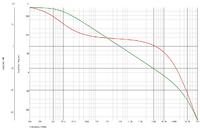Colon
Member level 3

Hey there,
There have been a couple of similar questions before on this topic, but not exactly what I'm looking for.
So, having read the criteria from several sources, for an op amp to oscillate you need the following from the bode plot of the LOOP GAIN (ie. AB):
1) 180 degrees phase shift (from dc). Depending on the input you apply your ac source, this gives a phase of 180 (+ input) or 0 (- input) in the bode plot.
2) gain at the point of the 180 degrees phase shift.
Ok, I have simulated my loop gain in spice by breaking the loop with a huge inductor, to maintain the dc conditions needed for the ac analysis to occur. I look at the bode plot and my loop gain drops off below unity at 5MHz. My phase doesn't reach 180 degrees til 200MHz, by which point the gain is down to -40dB. op amp stable right? Wrong, I have made this op amp (which has a fair amount of gain, 50dB) and it oscillates at 200MHz.
Even allowing for parasitics I don't see how this design can be simulated to be unstable. The bit that is bothering me is that the loop gain plot will continue to decrease if I increase my feedback resistor as B (=Rg/(Rg+Rf)) will decrease(increase my closed loop gain). If this graph decreases, it will cross the unity gain line at an even lower frequency, suggesting it will be even more stable. Yet, we all know increasing our closed loop gain will make an op amp less stable.
Something here is wrong, and I can't work out what it is. any ideas?
Thanks
James
There have been a couple of similar questions before on this topic, but not exactly what I'm looking for.
So, having read the criteria from several sources, for an op amp to oscillate you need the following from the bode plot of the LOOP GAIN (ie. AB):
1) 180 degrees phase shift (from dc). Depending on the input you apply your ac source, this gives a phase of 180 (+ input) or 0 (- input) in the bode plot.
2) gain at the point of the 180 degrees phase shift.
Ok, I have simulated my loop gain in spice by breaking the loop with a huge inductor, to maintain the dc conditions needed for the ac analysis to occur. I look at the bode plot and my loop gain drops off below unity at 5MHz. My phase doesn't reach 180 degrees til 200MHz, by which point the gain is down to -40dB. op amp stable right? Wrong, I have made this op amp (which has a fair amount of gain, 50dB) and it oscillates at 200MHz.
Even allowing for parasitics I don't see how this design can be simulated to be unstable. The bit that is bothering me is that the loop gain plot will continue to decrease if I increase my feedback resistor as B (=Rg/(Rg+Rf)) will decrease(increase my closed loop gain). If this graph decreases, it will cross the unity gain line at an even lower frequency, suggesting it will be even more stable. Yet, we all know increasing our closed loop gain will make an op amp less stable.
Something here is wrong, and I can't work out what it is. any ideas?
Thanks
James

